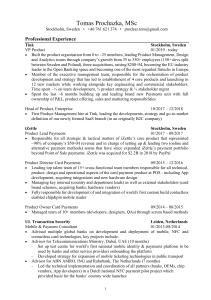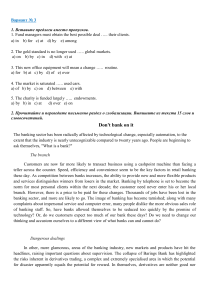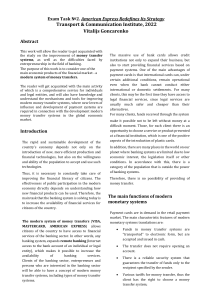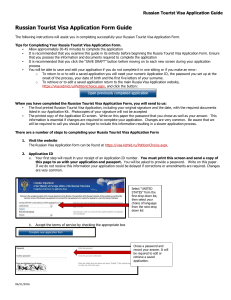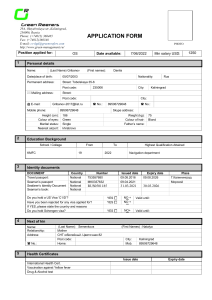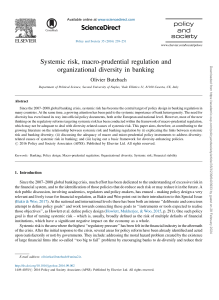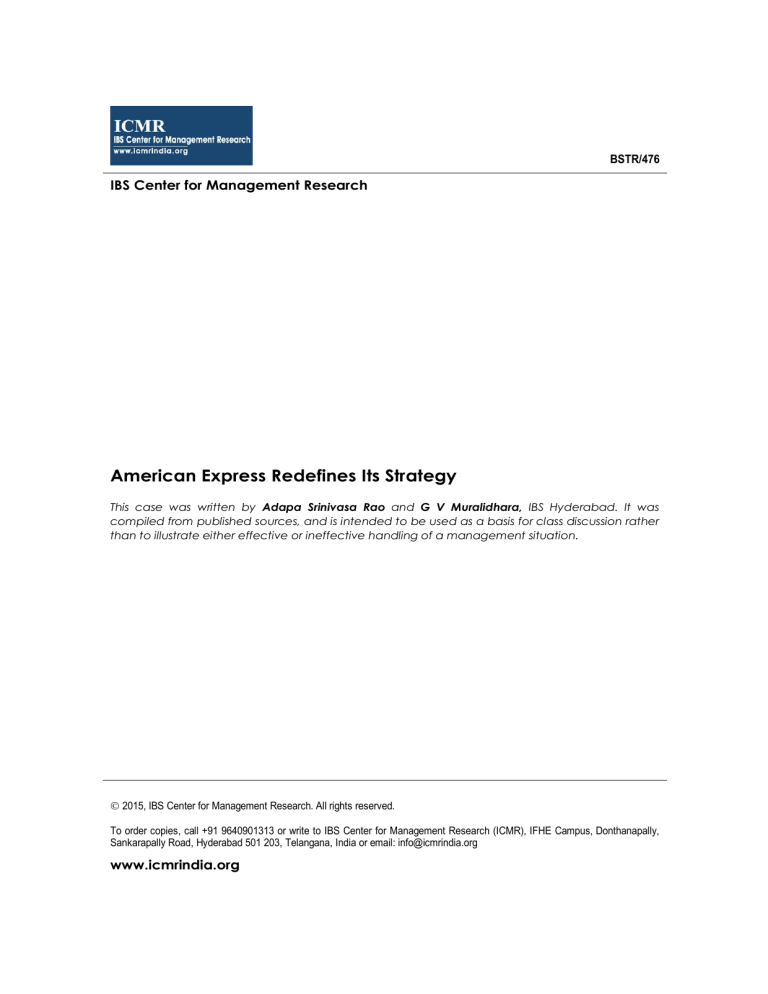
BSTR/476 IBS Center for Management Research American Express Redefines Its Strategy This case was written by Adapa Srinivasa Rao and G V Muralidhara, IBS Hyderabad. It was compiled from published sources, and is intended to be used as a basis for class discussion rather than to illustrate either effective or ineffective handling of a management situation. 2015, IBS Center for Management Research. All rights reserved. To order copies, call +91 9640901313 or write to IBS Center for Management Research (ICMR), IFHE Campus, Donthanapally, Sankarapally Road, Hyderabad 501 203, Telangana, India or email: info@icmrindia.org www.icmrindia.org BSTR/476 American Express Redefines Its Strategy “We are becoming a more inclusive brand, a more welcoming brand to a broader range of American consumers, all the way from prepay to premium.”1 – Josh Silverman, American Express President for Consumer Products and Services in March 2014. “If your vision is designed around service as the primary core business – of what you wake up and do every day – it allows you to evolve and in many cases cannibalize and change the business you’re in.”2 – Howard Grosfield, CEO of American Express Canada in November 2014. INTRODUCTION In February 2014, American Express launched a new credit card called the ‘Amex EveryDay Credit Card’ (Amex EveryDay). This card did not have any annual fee but had a unique rewards program that rewarded frequent users. Unlike the other offerings from American Express which were traditionally targeted at busy executives and entrepreneurs, Amex EveryDay was targeted at housewives and students. The card was part of the strategic shift at American Express to target the mass market rather limiting its offerings to premium customers. Since the time it entered the card business, American Express had operated a closed-loop network and focused on a limited number of profitable customers. It also charged higher commissions from the merchants than other banks and card companies. Despite offering its products to a limited group of customers, American Express enjoyed a higher share of the total card spending. In the mid-2000s, American Express started facing new challenges from online payment processing companies and other card companies. The online payment processing companies offered safe and cheaper payment processing services which lured customers from the conventional card companies. Big commercial banks and credit card companies that processed transactions through their open-looped networks too started giving higher competition to American Express by offering super premium cards. Cards like the Visa Infinite and Sapphire Card from JPMorgan Chase & Co. offered features similar to that of high-end cards from American Express. Faced with the prospect of losing its affluent customers and the growing market for online payment processing, American Express launched new products and services to reach new customer segments which it had traditionally ignored. New products like the ‘Bluebird’ prepaid card, ‘Serve’ digital payment system, and the ‘American Express PAYBACK Credit Card’ were launched targeting the mass market. The company also started focusing on offering basic banking services to its customers. American Express converted itself into a banking holding companya during the financial crisis of 2008 and started rolling out cheaper banking products like savings accounts with low balance requirements. Most of the newly launched products were received well in the market. Some analysts supported the shift in the business strategy of American Express. But others were skeptical about the success of the new strategy. They opined that American Express might end up losing its premium brand image in the market and thus its premium customers. a According to the American Bank Holding Company Act of 1956, a bank holding company is a company that controls one or more banks. 1 American Express Redefines Its Strategy AMERICAN EXPRESS- BACKGROUND NOTE American Express Company (American Express) was founded in the year 1850 as an express mail business. The company was formed with the merger of some leading express companies of the time like Wells & Company, Livingston, Fargo & Company, and Wells, Butterfield & Company. In the initial days of its operation, it enjoyed a monopoly on the movement of all kinds of express shipments like goods, securities, and currency in New York State. In subsequent years, the company started expanding its reach to cover all parts of the country by entering into business agreements with other companies in businesses like express mail, railroads, and shipping. In the year 1882, American Express started expanding into the business of financial services by launching the money order business. The company became a major player in the international financial services business with the launch of American Express Traveler’s Cheques in the year 1891. The Traveler’s Cheques issued by American Express quickly became popular as they were accepted in all the major cities of the world. In the year 1915, American Express entered the travel services business, which went on to become one of its most lucrative businesses in the later years. Its travel services business, which later came to be known as ‘American Express Travel & Lifestyle Services’, offered premium travel services to affluent customers in both the USA and other countries. In the year 1917 (during World War I), the then president of the US, Woodrow Wilson, commanded that all the railroads in the country be merged into one single company to aid the war efforts. As a result of this move, American Express suffered a major setback with the loss of its railroad business. In the year 1958, American Express entered into the payments business with the launch of its first charge cardb. This card proved to be a huge success in the market and was followed by other charge cards like the Gold Card in1966 and the Platinum Card in the year 1984.With the success of its charge card business, American Express launched its first credit card called the ‘Optima Card’ in the year 1987. The Optima Card was an instant success among young customers as it allowed its users to carry over the balance to the subsequent month without having to pay the whole balance. In subsequent years, American Express introduced multiple credit cards to suit the needs of customers from different income segments. In the year 1999, American Express launched a super premium charge card called the ‘Centurion Card’ targeted at rich customers. The Centurion Card was offered only by invitation to the users of its Platinum Card. It was made of titanium and had no preset credit limit. American Express also issued a number of co-branded cards in partnership with airlines, hotels, retailers, etc. that offered higher benefits to the customers. Apart from the charge cards issued to retail customers, American Express issued a range of commercial cards (popularly called Corporate Cards) to help mid-size and large companies effectively manage their operating expenses. In the year 2008, the company further strengthened its business services division by acquiring GE’s Corporate Payment Services business. As part of its travel services business launched in the year 1915, American Express started publishing travel guides for its customers who were traveling all over the world. In the year 1968, American Express acquired U.S. Camera Publishing Co. which published a monthly travel magazine called U.S. Camera and Travel. 3 American Express renamed the magazine ‘Travel & Leisure’ and invested resources to expand its reach. By 1970, Travel & Leisure had become the highest selling travel magazine in the US. Over the years, the publishing arm of American Express launched other popular magazines like ‘Food & Wine’, ‘Black Ink’, ‘Departures’, etc. In the year 2013, American Express sold off its publishing business to Time Inc. due to banking regulations that restricted companies in the banking business from runing non-financial businesses. 4By the year 2014, American Express was concentrating on aggressively expanding its financial services business. For the fiscal year 2013, its total revenues were US$ 33 billion (Refer to Exhibit- I for select financials of American Express). b Charge cards are similar to credit cards where the customer is billed periodically for the transactions made on the card. The only difference between the two is that that the customer needs to pay the whole balance on the charge card and cannot carry it over to the next billing cycle. 2 American Express Redefines Its Strategy GLOBAL PAYMENT CARD INDUSTRY The global payment card industry was highly competitive and was dominated by a few big companies. The higher entry barriers of the industry in the form of high investments needed to build the network and time taken to build reliable brands prevented new players from entering and succeeding in the industryc. Despite the presence of a number of smaller players supported by local governments, the payment card industry was mostly concentrated in the USA. Two American companies, Visa and MasterCard, had a significant market share in terms of the total cards in circulation. However, in terms of the total value of transactions made by customers, American Express led the industry. Banks played a leading role in the global payment industry by issuing the credit cards to their customers, bearing the default risks, providing support to customers, etc. The global payments industry was expected to grow at a healthy rate with an annual increase of total payments at 5 percent till the year 2016.d Noncash payment products were mostly preferred in the USA, Europe, and some big Asian economies. With the higher preference for non-cash payment instruments in North America, people used cards to make their payments.5 Going forward, the industry’s growth in the developed markets was expected to be modest as the market was already well penetrated by major card issuing companies. Most of the future growth was expected to come from emerging economies like China and India. The increasing prosperity of consumers in the emerging markets coupled with the spread of financial services were the main reasons for the high growth projections of payment cards industry in these markets. BUSINESS MODEL OF AMERICAN EXPRESS Since the time it entered the card business, American Express had followed a very unique business model when compared with other credit card companies. It maintained its own closed-loop network that did not process the card transactions of other credit card companies (Refer to ExhibitII for network models of different card companies). It directly issued its own cards to the customers and extended the required credit for the purchases made. Instead of focusing on transaction volumes, American Express always focused on the spend volumes of its customers. A few premium customers of the company gave it higher revenues than the large number of small customers for other credit card companies. For the year 2013, Visa processed a total of 60 billion transactions with 2 billion cards. During the same period, American Express processed 6 billion transactions with just 107 million cards in use. A limited number of transactions helped it in controlling its costs, leading to higher profitability. The cards issued by American Express had high membership fees which made them unaffordable to low income customers. In return for the high membership fees charged for its cards, American Express offered a premium loyalty program (called the Membership Rewards program) that rewarded its customers in the form of gifts, air miles, club memberships, access to airport lounges, etc. Since American Express operated its own network, it was able to get valuable insights regarding the spending patterns of the customers so that it could send customized marketing offers. Such offers helped the company maintain a good relationship with its customers while encouraging the customers to stay loyal. The insights it gained through the past spending habits of c d There are different types of payment cards in the market like credit cards, debit cards, charge cards, and prepaid cards. Debit cards and Prepaid require users to have ,money deposited in their bank/card accounts to make transactions. However, banks and credit card companies give credit on transactions made through credit cards and charge cards. Customers will be charged a fixed rate of interest on the amount outstanding in their card accounts. Sukriti Bansal, Philip Bruno, FlorentIstace, and Marc Niederkorn, “Global Payments Trends: Challenges Amid Rebounding Revenues,” McKinsey on Payments, September 2013. 3 American Express Redefines Its Strategy customers also made it possible for American Express to match them with the right merchants and incentivize higher spending. American Express charged a higher commission per transaction from each merchant than other card companies. In return, merchants who accepted its cards got access to its affluent customer base with its high spending power. Due to its exclusive focus on such lucrative customers, American Express had a low market share of 9.2 percent of the total credit card market in the year 2013 (Refer to Exhibit- III for the market share of major card companies). However, it experienced a continuous growth in its billed business for the five years preceeding 2013 (Refer to Exhibit- IV for billed business of American Express from the year 2009 to 2013). The flipside of issuing its own cards was that American Express had to extend credit on its own to the customers and incur losses due to payment defaults by the customers. However, as the company exclusively focused on affluent customers, it had the lowest percentage of loans that were past the due date. While an average of 2.39 percent of the total credit card loans issued by American commercial banks were past the payment deadline for the month of October 2013, just 1.07 percent of the credit card loans issued by American Express in USA were due past the deadline. 6 American Express followed a similar model for its travel services. Even though the travel services were initially targeted at the general population, it later restricted them mostly to its business clients. Its travel services helped big businesses to effectively manage the travel requirements of their executives. Other major credit card companies like Visa and MasterCard followed a business model that was based on the volume of transactions generated by their business activities. They did not issue cards directly to the customers. Instead, they issued cards through banks and other financial institutions which were members of their network. These cards were used by consumers to buy goods and services from merchants. All the transactions made through the cards bearing the logos of Visa and MasterCard were routed through their networks to the card issuing banks. The open-loop system of these companies allowed any bank in the world to issue globally accepted credit and debit cards. Payments were processed once the banks authorized the transaction after checking the availability of funds in the accounts or credit limits of the customers. Visa and MasterCard made money from the data processing and from service fees from their clients.7 Apart from the fees, credit card companies did not earn any other income like interest and other fees directly from the customers. All the risks related to the credit issued to the customers like payment defaults were borne by the card issuing banks. As Visa and MasterCard issued cards through a number of banks all over the world, the small fees earned from each of their clients when pooled became a revenue source for these companies. Visa and MasterCard charged extra fees for value added services like dispute resolution and loyalty reports. NEW CHALLENGES Since the mid-2000s, the major card companies in the world including American Express had been facing new competition from online payment processing companies like PayPal. Many Silicon Valley based technology companies too entered the payments business and introduced online, mobile, and cloud-based services that directly competed with the services provided by the conventional card companies.8 The difference between the conventional card issuing companies and online payment processing companies became blurred as these companies made it possible for payments to be made at physical merchant points of sale (POS) units through mobile phones. Unlike the conventional charge and credit cards which had fixed annual fees, the services of online payment processing companies were cheap or totally free for the customers. American Express also started facing higher competition from banks and credit card companies. As the default rates in the subprime market increased due to the global financial crisis of 2008, many big banks started targeting affluent customers. Credit card companies and banks started launching premium and superpremium cards targeted at their rich clients. In the year 2009, 4 American Express Redefines Its Strategy JPMorgan Chase & Co.e launched a premium credit card called the ‘Sapphire Card’ targeted at the richest 15 percent of American households.9The Sapphire Card offered an exclusive rewards programs similar to the one offered by American Express. In the same year, JPMorgan Chase & Co introduced a charge card which was also the first charge card issued on the Visa/MasterCard networks. Visa and MasterCard also launched super premium cards targeted at rich customers. Cards like ‘Visa Infinite’ and ‘World Elite MasterCard’ offered similar features to that of American Express Platinum and Centurion Cards for a higher membership fee. These super premium cards could be issued by any bank in the world that fulfilled the requirements set by Visa and MasterCard. Since the super premium cards that worked on the networks of Visa and MasterCard had higher acceptance around the world than those issued by American Express, business executives and rich customers started preferring them to the latter. CHANGING BUSINESS STRATEGY The changing payments business worldwide forced American Express to consider changing its business strategy. The prospect of losing its affluent customers could limit the future growth of the company. At the same time, there was no way for the company to introduce more premium products as it had already served the top end of the market with its premium and superpremium products like the American Express Platinum and Centurion Cards (Refer to Exhibit-V for the list of cards issued by American Express in USA). The explosive growth of e-commerce made it difficult for American Express to ignore the business of digital payments. In view of the changing market conditions, American Express changed its business strategy to focus on both the premium and mass markets with new products. Recognizing that online payments were reshaping financial transactions, American Expess launched its own digital payment system called ‘Serve’ in the year 2011.10 Serve competed with other online digital payment services like PayPal and had similar features. Users of Serve could make payments to online merchants through the Serve website and their mobile phones. The Serve account could be funded through transfers from bank accounts, credit cards, and transfers from other Serve accounts. As cash could be easily transferred from one Serve account to the other, the service also acted as both a payment and money transfer solution for customers. With Serve, American Express hoped to reach customer segments that neither used physical cash nor plastic cards to make payments and thereby emerge as a provider of software based payment solutions. Commenting on the introduction of the Serve digital payment system, Dan Schulman, group president of enterprise growth at American Express, said, “This is really the first time that American Express is going to be able to address those consumers that typically would utilize either a debit card or checking account. There’s a large cultural shift happening at American Express in terms of us really moving to becoming more of a software- and platform-based company.”11 In the year 2013, American Express made it possible for the users of Serve to use physical cards issued by the company to make payments at online and offline stores.12 The additional facility of using plastic cards to make payments increased the utility of the Serve payment system. Other than targeting customers who did not have regular bank accounts in the western markets, American Express also wanted to use Serve to expand in developing countries where customers were directly moving from cash to mobile payments.13 American Express introduced new card products with little or very low membership fees to attract more consumers to the company. In the year 2012, it launched a new prepaid card called Bluebird in partnership with WalMart Stores. Bluebird was positioned as an alternative to the regular checking accounts and debit cards issued by commercial banks. The card was targeted at e JPMorgan Chase Chase& Co. is an American banking and financial services company. It is headquartered in Manhattan, New York, USA. 5 American Express Redefines Its Strategy customers who were concerned with the increasing costs of running regular bank accounts. Commercial banks in the US charged higher charges for using their ATM services and overdraft services and for non maintenance of monthly and quarterly balances. The Bluebird prepaid card was accepted at all the locations where the regular American Express cards were accepted. Customers could get a Bluebird card from WalMart Stores or the special website14 created for the card. Cash could be transferred to the Bluebird cards easily from the regular checking accounts of customers, through free deposits at the checkout registers of WalMart stores, and through the direct transfer of paychecks. The prepaid card had a number of features that were generally available with the conventional checking accounts offered by commercial banks. While the prepaid cards issued by other companies allowed the customers to just load money on their cards and use it at shopping outlets, Bluebird was designed to be a compelte alternative to the regular savings accounts from commercial banks. Bluebird card users could easily manage their everyday finances with features like withdrawing money from ATMs, writing checks, setting up subaccounts, and paying utility bills. Access was also free to ATMs with which American Express had a tie-up. The card was given free of cost and without any annual maintenance charges having to be paid. 15 American Express made money through the commissions paid by merchants when the Bluebird card was used for purchases and and through the fees charged for using the card at ATMs outside its network. With the Bluebird, American Express hoped to reach customers that it could not through its conventional charge and credit cards. WalMart on its part hoped the card would help attract more customers to its brick and mortar stores and ecommerce store.16 Other than luring the customers of regular commercial banks, American Express also hoped to target people who had never had a checking account with commercial banks.17 Seeking to offer a suitable alternative to the credit cards of banks, American Express too came up with cheaper credit cards with low or no maintenance charges. In February 2014, it launched a new credit card called ‘Amex EveryDay Credit Card’ (Amex EveryDay) targeted at the mass market. Unlike conventional card products from the company, Amex EveryDay did not have any annual fees.The new card was aimed at increasing the reach of its card products to customers who were averse to paying membership fees for their credit cards and hence preferred the payment products of rivals like Visa and MasterCard. Apart from not having an annual fee, the Amex EveryDay card also had a uniqe rewards program that encouraged its customers to use the card more frequently. Customers who used the card for a minimum of twenty times a month could earn 20 percent extra reward points. Rather than redeeming the reward points for merchandise or cash, all the reward points that were earned on the card could be transferred to American Express’ business partners like airlnes and converted into airmiles. Under the EveryDay series, the company also launched another card called Amex EveryDay Preferred Card. This had a nominal annual fee of US$ 95 per year and offered more features.The main target customers for the new EveryDay range of cards were housewives, students, and junior professionals who shopped frequently in small quantities. Commenting on the launch of the Amex EveryDay Credit Card, Josh Silverman, President, Consumer Products and Services, said, “Our goal is to be a more inclusive and welcoming brand by building new products for different lifestyles and spending needs, backed by the service and quality that has made American Express so successful.”18 The reach of American Express in emerging markets like India was limited as many persons there were not eligible for its premium cards. In order to expand its reach in such markets, American Express introduced a new range of credit cards under its PAYBACK brand. PAYBACK was a loyalty program brand acquired by American Express when it took over PAYBACK’s parent company Loyalty Partner in the year 2011. Customers who owned the PAYBACK loyalty card could gain and redeem reward points at any of the merchants enrolled for the program. American Express used the PAYBACK brand to launch the American Express PAYBACK Credit Card and American Express MakeMyTripf Credit Card in 2013 and 2014. These cards allowed the f MakeMyTrip is one of the premium travel portals in India. The American Express MakeMyTrip Credit Card was launched as a co-branded credit card between MakeMyTrip and PAYBACK. 6 American Express Redefines Its Strategy customers to redeem the reward points at any of merchants which were part of the PABACK network. The American Express PAYBACK Credit Card was free for customers whose total spending in a year exceeded US$ 2,443. BANKING BUSINESS In the year 2007, American Express sold its subsidiary company American Express Bank Ltd. to Standard Chartered PLC for a sum of US$ 1.1 billion. 19 American Express Bank had been providing banking services to financial institutions and high net-worth customers around the world. The decision to exit the banking business was taken to enable the company to focus on its high-growth and high-return payments business. However, American Express continued to operate under restricted banking licenses in some countries like India which did not allow non-banking companies to offer financial services like issuing credit cards and travelers’ cheques. The changing financial business around the world made American Express refocus on its banking business. During the financial crisis of 2008, American Express converted itself into a bank holding company after getting approval from the Federal Reserve System. 20 It started to aggressively push into the consumer banking space. Converting itself into a commercial bank enabled it to access cheap deposits from the public and get help from the government during the crisis. Instead of focusing on premium customers, the company started providing banking services to the mass market. As part of its banking services, American Express offered basic banking products like savings accounts and certificates of deposit.21 The new banking products were cheaper and did not charge customers for non-maintenance of minimum balances. The supreme court rulingg in the US in 2004, which allowed American Express to issue its cards through other banks in the country, helped it enter the open-loop network while effectively retaining its lucrative closed-loop network. 22 American Express looked to expand its reach through tieups with major U.S. banks. Some big American banks like U.S. Bankh reached an agreement with American Express to offer its cards to their customers. 23 However, the adoption of American Express cards was slow due to the competition from Visa and MasterCard. IMPACT ON THE BRAND VALUE With the introduction of new products, American Express was redefining itself as a reliable financial ‘service provider’ available to all kinds of customers rather than as an issuer of charge/credit cards. Rather than targeting every new product and new technology that was being introduced in the market, it wanted more customers to believe that American Express was the brand for their financial needs. The new products from American Express targeted at the mass market were well received in the market. Some analysts praised its efforts Express to reach the mass market. However, some analysts were skeptical about American Express’s attempt to focus on both the premium and mass markets with different products under the same umbrella brand. They opined that the new mass market products might adversely impact the company’s brand. Many customers of American Express considered its cards as a symbol of accomplishment in life. American Express too had positioned its products as something customers had ‘membership’ and ‘access’ to.24 The premium image of American Express enabled the company to earn higher revenues in the g h In the year 2004, the American Supreme Court ruled that both Visa and MasterCard had violated antitrust rules by restricting their member banks from offering credit/charge cards that could be used on other payment networks. American Express and Discover Financial filed lawsuits claiming damages. These lawsuits were later settled out of court. U.S. Bank is the fifth largest commercial bank in USA. It is part of the U.S. Bancorp holding company headquartered in Minneapolis, Minnesota, USA. 7 American Express Redefines Its Strategy form of annual membership fees. Merchants too were willing to pay higher commissions as they were able to gain access to high spending customers. Some analysts felt that premium customers could leave the company if the brand value of American Express became diluted due to the cheaper products. Some other analysts opined that the premium image of American Express might prevent low income customers from even trying out the new products. OUTLOOK American Express exited from some of its noncore businesses to concentrate on financial services. In the year 2014, it separated its business travel division and entered into a joint venture with an investor group led by Cetaras LP to run its travel business. American Express was to share the responsibility of managing the joint venture with its partner.25 The main objective of separating the business travel division was to free up funds for investing in other initiatives taken by the company. Meanwhile, the competition in the payments business was increasing further with the entry of big technology companies. In October 2014, Apple launched a new payments system called Apple Pay, which allowed customers to pay for their purchases safely from their mobile phones.26 Apple included advanced safety features like fingerprint recognition in the Apple Pay service to authenticate the transactions. Since Apple had a significant share of smartphones sold all over the world, analysts predicted that the new service would disrupt the payment card industry. Competition in the premium cards segment further intensified with more banks launching their own products targeted at affluent customers. In March 2013, Citibank launched a super premium credit card called Citi Prestige Card.27 The Citi Prestige Card offered a premium rewards program which offered customers Relationship Bonus Points over and above the regular reward points based on the length of their relationship with the bank and their total yearly spends. According to some industry analysts, the future of American Express would depend on how effectively it could convince both the premium and regular customer segments that it was a brand they could rely on. Since the time the company was founded, American Express had weathered many crises that threatened its very survival. It remained to be seen how it would overcome the current challenges and emerge as the financial service provider of the future. 8 American Express Redefines Its Strategy Exhibit-I Select Financials of American Express (In US$ Millions) Item 2013 2012 2011 27,927 26,927 25,586 Total interest income 7,005 6,854 6,696 Expenses Total interest expense 1,958 2,226 2,320 5,047 32,974 4,628 31,555 4,376 29,962 2,110 1,990 1,112 Total revenues net of interest expense after provision for losses 30,864 29,565 28,850 Total expenses 22,976 23,114 21,894 5,359 4,482 4,935 Revenues Total non-interest revenues Net interest income Total revenues net of interest expense Provisions for losses Net income Source: Annual Report of American Express, 2013. Exhibit-II ‘3-Party Model’ of American Express and Models of Other Payment Companies American Express(Closed-Loop Network) Visa and MasterCard (Open-Loop Network) Source: http://cdn.nerdwallet.com/blog/3_party_model.png, http://www.capgemini.com/resource-fileaccess/resource/pdf/global_trends_in_the_payment_card_industry_2012_acquirers.pdf. 9 American Express Redefines Its Strategy Exhibit-III Market Share of Major Card Companies (End of 2013) Number of Cards in Circulation Card Company Market Share Average Annual Spending Visa 285 million 49.3% US$ 3,786 MasterCard 178 million 30.8% US$ 3,146 American Express 53.1 million 9.2% US$ 11,996 Discover 62 million 10.7% US$ 1,774 Source: http://www.cardhub.com/edu/market-share-by-credit-card-network. Exhibit-IV Billed Business of American Express (In US$ Billions) 952 1000 888 900 822 800 700 713 620 600 500 400 300 200 100 0 2009 2010 2011 Source: Annual Report of American Express, 2013. 10 2012 2013 American Express Redefines Its Strategy Exhibit-V Cards Issued by American Expressi Name of the Card Card Type Annual Fees Amex EveryDay Credit Card Credit US$ 0 Blue Cash EveryDay Card Credit US$ 0 American Express Premier Rewards Gold Card Charge US$ 175 TrueEarnings Card from Costco and American Express Credit US$ 0 The Starwood Preferred Guest Credit Card Credit US$ 65 Platinum Card Charge US$ 450 Blue Cash Preferred Card Credit US$ 75 American Express Green Card Charge US$ 95 Gold Delta SkyMiles Credit Card Credit US$ 95 Blue from American Express Credit US$ 0 Hilton HHonors Card Credit US$ 0 Amex EveryDay Preferred Credit Card Credit US$ 95 Platinum Delta SkyMiles Credit Card Credit US$ 195 JetBlue Card Credit US$ 40 American Express Gold Card Charge US$ 125 Blue Sky Credit US$ 0 Blue Sky Preferred Credit US$ 75 Delta Reserve Credit Card Credit US$ 450 Hilton HHonors Surpass Card Credit US$ 75 The Mercedes-Benz Credit Card Credit US$ 95 Source: https://www304.americanexpress.com/credit-card/compare/?inav=menu_cards_pc_viewallcards. i In USA as on January 26, 2014. 11 American Express Redefines Its Strategy Endnotes: 1 2 3 4 5 6 7 8 9 10 11 12 13 14 15 16 17 18 19 20 21 22 23 24 25 26 27 Hilary Stout, “With New Rewards Card, Amex Focuses on Busy-Mom Market,” http://www.nytimes.com, March 2, 2014. Jacqueline Nelson, “American Express Shake-up to Rely on Trusted Brand, Customer Service,” http://www.theglobeandmail.com, November 3, 2014. “99 Years of Content Marketing: How American Express Became a Major American Publisher,” http://contently.com. “It’s Official: Time Inc. Buys AmEx’s Food & Wine, Travel & Leisure Magazines,” http://adage.com, September 10, 2013. “Global Trends in the Payment Card Industry 2012: Issuers,” http://www.capgemini.com/resource-fileaccess/resource/pdf/global_trends_in_the_payment_card_industry_2012_issuers_0.pdf, 2012. “Delinquency Rate on Credit Card Loans, All Commercial Banks,” http://research.stlouisfed.org/fred2/data/DRCCLACBS.txt. “How has Visa Achieved Double Digit Growth and is it Sustainable?” http://www.trefis.com, March 6, 2014. John Huggestuen, “Emerging Payment Technologies will Create New Winners and Losers in the Giant Credit Card Industry,” http://www.businessinsider.in, May 19, 2014. Juan Lagorio, “JPMorgan Challenges AmEx in Credit Card Industry,” http://www.reuters.com, October 9, 2009. Audrey Watters, “A Challenge to PayPal? American Express Launches Digital Payments,” http://readwrite.com, March 28, 2011. Margaret Collins, “AmEx Pushing World Expansion Takes on EBay’s PayPal with Prepaid E-Wallet,” http://www.bloomberg.com, March 29, 2011. Sarah Perez, “American Express Serve Goes After the ‘Under-Banked’ with Prepaid Cards you Load with Cash in Stores,” http://techcrunch.com, October 8, 2013. Nick Summers, “American Express Wants to be Your Banker,” http://www.businessweek.com, October 25, 2012. The official website for Bluebird card is www.bluebird.com. “what is Bluebird?” https://www.bluebird.com. Emily Jane Fox, “Wal-Mart and American Express Launch New Prepaid Card,” http://money.cnn.com, October 8, 2012. “Amex Launches Bluebird Card for Wal-Mart,” http://bankingfrontiers.com. “American Express Announces New No Annual Fee Credit Card, the Amex EveryDay Credit Card,” http://about.americanexpress.com/news/pr/2014/no-fee-amex-everyday-credit-card.aspx, February 28, 2014. “American Express Company Agrees to Sell American Express Bank Ltd. To Standard Chartered PLC. Sale Reflects American Express’ Continued Focus on High-Growth, High-Return Payments Businesses,” http://ir.americanexpress.com/Mobile/file.aspx?IID=102700&FID=4860504, September 18, 2007. AviSalzman, “The New AmEx,” http://online.barrons.com, September 13, 2014. Nick Summers, “American Express ‘EveryDay’ Card: For Trucks, Not Faberge,” http://www.businessweek.com, March 3, 2014. Eric Dash, “MasterCard Will Pay US$ 1.8 billion to American Express,” http://www.nytimes.com, June 26, 2008. “U.S. Bank and American Express Announce Card-Issuing Agreement,” http://about.americanexpress.com, November 20, 2013. Jacqueline Nelson, “American Express Shake-up to Rely on Trusted Brand, Customer Service,” http://www.theglobeandmail.com, November 3, 2014. Samantha Sharf, “American Express to Spin Off Business Travel Division into Joint Venture,” http://www.forbes.com, March 17, 2014. Donna Tam and SharaTibken, “Apple Pay Mobile Payments Service to Launch on Monday,” http://www.cnet.com/news/apple-pay-mobile-payment-service-to-launch-on-monday, October 16, 2014. “Citibank Launches its First Global Credit Card for the Affluent Segment,” http://www.citigroup.com, March 4, 2013. 12

